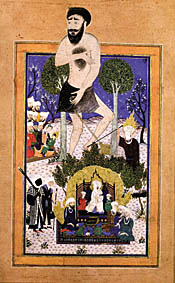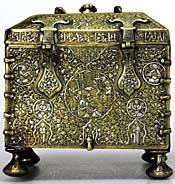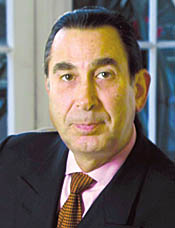
The Giant Uj and the prophets Moses, Jesus and Mohammed,
early 15th century

Brass and silver casket with a four dial combination lock,
from Jazira, first half of 13th century

Carved ivory box from Umayyad, Spain, 960AD

Professor David Nasser |
Islamic art and the Jewish connoisseur
Professor David Nasser Khalili
owns the largest collection of Islamic art in the world, but
it's not about financial investment, he tells Dan Carrier
BUYING art is not an investment – it is about safeguarding
cultural items for future generations, and making them accessible
for people today.
This is the view of the largest private collector of Islamic
art in the world, Professor David Nasser Khalili, who will be
discussing his collection of Islamic art on Wednesday at the
Jewish Book Week.
And although many find it surprising, Prof Khalili is not a
Muslim – he is Jewish.
“I simply happen to be fascinated by Islamic art,” he says.
And Prof Khalili wants the world to join him in celebrating
the superb legacy of Islamic architecture, calligraphy and art
in general.
He is from Tehran – and that means he feels the Iranian
Islamic world is as much his cultural heritage as his Jewish
background: “I grew up to with Islam and its beauty,” he says.
Prof Khalili, who teaches at the School of Oriental and African
Studies in Bloomsbury, has used a self-made personal fortune
to amass over 20,000 artefacts.
His fortune stems from property, but he had made money as a
young boy. When he was 14 he spent a summer holiday writing
a book about the world’s 25 greatest geniuses. It became
a best seller, and he used the cash to fund travel from his
native Tehran when he was a young man, and from that, fuel his
interest in his field. Astute property deals secured his fortune
– he hit the news when he sold a mansion in Kensington
to Formula One boss Bernie Ecclestone for an approximate £70
million.
But art is where he wants to spend his fortune, and it is estimated
in 35 years he has accumulated treasures worth at least £500m.
He says his dream is not to be an art collector, someone who
decorates their home with beautiful objects. Instead he wants
to be an art philanthropist, some one who safeguards public
access to the world’s treasures – a philosophy that
was behind his offer to hand over his collection to a permanent
display in his adopted home of London.
“I’m driven as a collector by a passion for art and
a love for the contribution to humanity,” he says.
And Prof Khalili says every piece he buys has a place in his
heart.
“I consider my collection to be a symphony; everyone in
that symphony has a role so you cannot specifically say one
is more important than another.”
The idea of forming a collection based on Islamic influences
gives him a huge scope as a collector, he says. Islamic art
is not confined to a religious or ethnic pigeonhole.
He said: “The term ‘Islamic art’ broadly describes
works produced by Muslim artists for Muslim patrons. ‘Islamic’
does not imply that the art is exclusively religious in content
or use, indeed a significant portion is secular. It is ‘Islamic’ because its artistic vocabulary is partly rooted in Muslim philosophical
thought and shaped to some extent by the spirit and doctrines
of the Muslim faith. This is why it can be discussed as a whole
in spite of the wide geographical area in which it was produced
and the fact that Muslim artists and architects have been influenced
and enriched by the artistic traditions of the other cultures
with which they came into contact.”
And he believes by celebrating the beauty of Islam, he can help
educate people – and change their perceptions. He hopes
this will bring a greater understanding between Muslims and
the West.
He said: “How can ignorance and prejudice about Islam be
dispelled? One way is to show and publicise the amazing achievements,
what they have brought to the world.”
He has, for the first time, collated manuscripts of the Qu’ran
and systematically assembled them in a chronological order to
demonstrate their growth and the development of calligraphy
in religious texts.
He has done the same with other artefacts such as glass and
earthenware, to allow the layman to understand the historical
growth of Islamic art and its effects and influences on the
societies that produced it.
One of his overwhelming aims is to use his collection as a unifying
influence.
He said: “I have always believed that religion and politics
have their own language but the language of art is universal.
“You cannot find a more unifying factor than the universality
of art. As a Jewish collector of Islamic art, I consider my
contribution to Islamic culture as if from one member of the
family to another.”
CLICK BELOW TO SEARCH FOR ACCOMODATION
|





